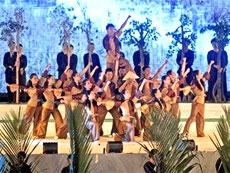A week of cultural and tourist activities started in the southernmost province of Ca Mau on April 25 to commemorate the 35th anniversary of the liberation of southern Vietnam and receive the UNESCO’s decision recognising Ca Mau Cape as the world’s biosphere reserve. The event is a chance for the province to introduce its economic potentials, especially in ecological tourism and raise the people’s awareness on environment protection amid the modernisation and industrialisation process, Trong said.

Truong Vinh Trong, Party Politburo member and Deputy Prime Minister; Ha Thi Khiet, Head of the Party Central Committee’s Commission for People’s Mobilisation; officials from Mekong Delta provinces and over 10,000 local people attended the opening ceremony of the Ca Mau Cape Tourism-Culture Week 2010.
On the occasion, the Deputy PM urged Ca Mau to pay more attention to preserving its wetlands ecosystem and tapping into the economic and scientific potentials of the Ca Mau Cape biosphere reserve in an effective and sustainable way.
The UNESCO on May 26, 2009 voted for the recognition of Ca Mau Cape as a world biosphere reserve together with 21 other sites in 17 countries across the world at a meeting held in Jeju, the Republic of Korea.
Ca Mau Cape, the southernmost part of the country, sprawls an area of 371,506ha with the core zone strictly safeguarded from any poaching and humans encroachments.
The core zone comprises of Ca Mau and U Minh Ha national parks and coastal defensive forests to the West Sea in the Gulf of Thailand, boasting different ecosystems; salt-marsh forests and coastal waters.
The Ca Mau National Park has a diverse wetland ecological system marked with 93 flora species belonging to 38 families, 28 animal species from 13 families and six amphibian species from four families.